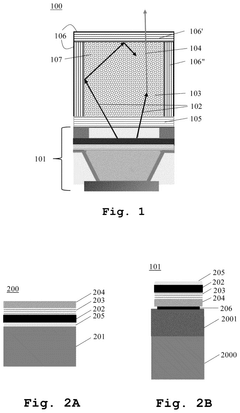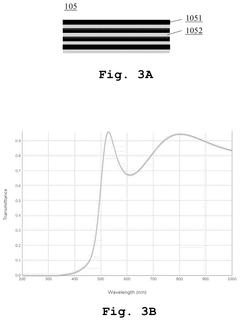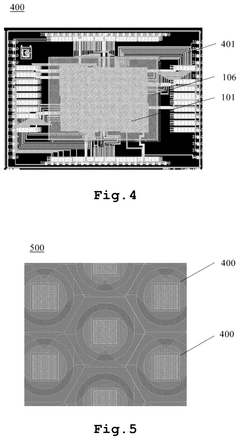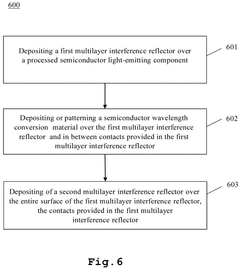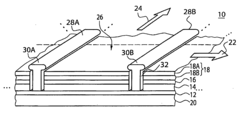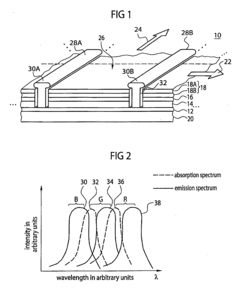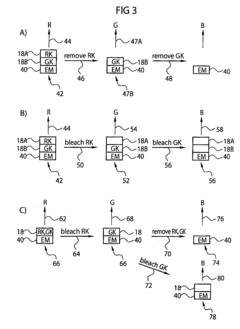ULED Technologies: Revolutionizing Display Spectrums
JUN 20, 20258 MIN READ
Generate Your Research Report Instantly with AI Agent
Patsnap Eureka helps you evaluate technical feasibility & market potential.
ULED Tech Evolution
ULED (Ultra Light Emitting Diode) technology has undergone a remarkable evolution since its inception, revolutionizing the display industry with its superior performance and energy efficiency. The journey of ULED began with the development of traditional LED technology, which laid the foundation for this advanced display solution.
In the early stages, researchers focused on enhancing the light output and color accuracy of LEDs. This led to the creation of high-brightness LEDs, which paved the way for larger and more vibrant displays. As the technology progressed, engineers tackled the challenge of miniaturization, resulting in the development of micro-LEDs. These microscopic light-emitting diodes offered unprecedented pixel density and contrast ratios.
The next significant milestone in ULED evolution was the integration of quantum dot technology. By incorporating quantum dots into LED displays, manufacturers achieved a wider color gamut and improved color accuracy. This breakthrough allowed ULED displays to reproduce colors more faithfully, enhancing the overall viewing experience.
Another crucial development in ULED technology was the implementation of local dimming techniques. This innovation enabled precise control over individual LED zones, dramatically improving contrast and black levels. As a result, ULED displays could achieve deeper blacks and more vibrant highlights, rivaling the performance of OLED screens.
The pursuit of energy efficiency has been a constant driving force in ULED evolution. Researchers have made significant strides in reducing power consumption while maintaining or even improving display performance. This has been achieved through advancements in LED driver circuits, more efficient phosphor materials, and optimized backlight designs.
Recent years have seen the emergence of Mini-LED technology as an intermediate step between traditional LED and micro-LED displays. Mini-LEDs offer many of the benefits of micro-LEDs, such as improved local dimming and contrast, while being more cost-effective to manufacture at scale.
Looking ahead, the ULED technology roadmap includes further advancements in micro-LED displays, with a focus on overcoming manufacturing challenges and reducing costs. Researchers are also exploring novel materials and structures to enhance light emission efficiency and color purity.
The evolution of ULED technology continues to push the boundaries of display performance, promising even more immersive and lifelike visual experiences in the future. As the technology matures, we can expect to see ULED displays becoming increasingly prevalent across a wide range of applications, from consumer electronics to professional displays and beyond.
In the early stages, researchers focused on enhancing the light output and color accuracy of LEDs. This led to the creation of high-brightness LEDs, which paved the way for larger and more vibrant displays. As the technology progressed, engineers tackled the challenge of miniaturization, resulting in the development of micro-LEDs. These microscopic light-emitting diodes offered unprecedented pixel density and contrast ratios.
The next significant milestone in ULED evolution was the integration of quantum dot technology. By incorporating quantum dots into LED displays, manufacturers achieved a wider color gamut and improved color accuracy. This breakthrough allowed ULED displays to reproduce colors more faithfully, enhancing the overall viewing experience.
Another crucial development in ULED technology was the implementation of local dimming techniques. This innovation enabled precise control over individual LED zones, dramatically improving contrast and black levels. As a result, ULED displays could achieve deeper blacks and more vibrant highlights, rivaling the performance of OLED screens.
The pursuit of energy efficiency has been a constant driving force in ULED evolution. Researchers have made significant strides in reducing power consumption while maintaining or even improving display performance. This has been achieved through advancements in LED driver circuits, more efficient phosphor materials, and optimized backlight designs.
Recent years have seen the emergence of Mini-LED technology as an intermediate step between traditional LED and micro-LED displays. Mini-LEDs offer many of the benefits of micro-LEDs, such as improved local dimming and contrast, while being more cost-effective to manufacture at scale.
Looking ahead, the ULED technology roadmap includes further advancements in micro-LED displays, with a focus on overcoming manufacturing challenges and reducing costs. Researchers are also exploring novel materials and structures to enhance light emission efficiency and color purity.
The evolution of ULED technology continues to push the boundaries of display performance, promising even more immersive and lifelike visual experiences in the future. As the technology matures, we can expect to see ULED displays becoming increasingly prevalent across a wide range of applications, from consumer electronics to professional displays and beyond.
Display Market Trends
The display market has been experiencing significant growth and transformation in recent years, driven by technological advancements and changing consumer preferences. The global display market size reached $148 billion in 2021 and is projected to grow at a CAGR of 7.2% from 2022 to 2030. This growth is primarily fueled by the increasing demand for high-quality displays in various applications, including smartphones, televisions, laptops, and automotive displays.
One of the most notable trends in the display market is the shift towards higher resolution and larger screen sizes. 4K and 8K displays are becoming increasingly popular, especially in the television segment. The demand for OLED (Organic Light-Emitting Diode) displays has been rising steadily, particularly in the smartphone and high-end TV markets, due to their superior picture quality, energy efficiency, and flexibility.
The automotive display market is experiencing rapid growth, driven by the increasing adoption of advanced driver assistance systems (ADAS) and in-vehicle infotainment systems. The market for automotive displays is expected to grow at a CAGR of 8.5% from 2022 to 2030, with a focus on larger, curved, and touch-enabled displays.
Another significant trend is the development of flexible and foldable displays. Major smartphone manufacturers have introduced foldable devices, and this technology is expected to expand to other product categories in the coming years. The market for flexible displays is projected to grow at a CAGR of 29.1% from 2022 to 2030.
The emergence of micro-LED and mini-LED technologies is also shaping the display market. These technologies offer advantages such as higher brightness, better contrast ratios, and improved energy efficiency compared to traditional LED displays. The micro-LED market is expected to grow significantly, with a projected CAGR of 80.1% from 2022 to 2030.
In the context of ULED (Ultra Light Emitting Diode) technologies, there is growing interest in expanding the color gamut and improving the overall visual experience. ULED displays aim to offer wider color spectrums, higher contrast ratios, and enhanced brightness levels compared to conventional LED and OLED displays. This aligns with the market trend towards more immersive and lifelike visual experiences across various applications.
The display market is also witnessing a shift towards more sustainable and energy-efficient technologies. Manufacturers are focusing on developing displays that consume less power and use environmentally friendly materials. This trend is driven by both consumer demand and regulatory pressures to reduce the environmental impact of electronic devices.
One of the most notable trends in the display market is the shift towards higher resolution and larger screen sizes. 4K and 8K displays are becoming increasingly popular, especially in the television segment. The demand for OLED (Organic Light-Emitting Diode) displays has been rising steadily, particularly in the smartphone and high-end TV markets, due to their superior picture quality, energy efficiency, and flexibility.
The automotive display market is experiencing rapid growth, driven by the increasing adoption of advanced driver assistance systems (ADAS) and in-vehicle infotainment systems. The market for automotive displays is expected to grow at a CAGR of 8.5% from 2022 to 2030, with a focus on larger, curved, and touch-enabled displays.
Another significant trend is the development of flexible and foldable displays. Major smartphone manufacturers have introduced foldable devices, and this technology is expected to expand to other product categories in the coming years. The market for flexible displays is projected to grow at a CAGR of 29.1% from 2022 to 2030.
The emergence of micro-LED and mini-LED technologies is also shaping the display market. These technologies offer advantages such as higher brightness, better contrast ratios, and improved energy efficiency compared to traditional LED displays. The micro-LED market is expected to grow significantly, with a projected CAGR of 80.1% from 2022 to 2030.
In the context of ULED (Ultra Light Emitting Diode) technologies, there is growing interest in expanding the color gamut and improving the overall visual experience. ULED displays aim to offer wider color spectrums, higher contrast ratios, and enhanced brightness levels compared to conventional LED and OLED displays. This aligns with the market trend towards more immersive and lifelike visual experiences across various applications.
The display market is also witnessing a shift towards more sustainable and energy-efficient technologies. Manufacturers are focusing on developing displays that consume less power and use environmentally friendly materials. This trend is driven by both consumer demand and regulatory pressures to reduce the environmental impact of electronic devices.
ULED Tech Challenges
ULED (Ultra Light Emitting Diode) technology faces several significant challenges as it strives to revolutionize display spectrums. One of the primary hurdles is achieving consistent and uniform light emission across large display areas. The miniaturization of LED chips to ultra-small sizes introduces complexities in maintaining uniform current distribution and heat dissipation, which can lead to inconsistencies in brightness and color accuracy.
Another major challenge lies in the manufacturing process of ULED displays. The production of ultra-small LED chips requires extremely precise fabrication techniques, pushing the boundaries of current semiconductor manufacturing capabilities. This precision requirement not only increases production costs but also impacts yield rates, potentially limiting the technology's widespread adoption in consumer electronics.
Color management presents a further technical obstacle for ULED technology. As the size of individual LED elements decreases, controlling the spectral output of each pixel becomes increasingly difficult. Achieving a wide color gamut while maintaining color accuracy and consistency across the entire display demands sophisticated color management systems and advanced materials engineering.
Power efficiency remains a critical concern in ULED development. While LEDs are generally energy-efficient, the ultra-small size of ULED chips can lead to increased power density and heat generation. Balancing power consumption with display performance is crucial, especially for mobile and wearable devices where battery life is a key consideration.
The integration of ULED technology with existing display architectures poses additional challenges. Adapting current manufacturing processes and supply chains to accommodate ULED production requires significant investment and innovation. Moreover, ensuring compatibility with various display drivers and control systems necessitates the development of new interface standards and protocols.
Durability and lifespan of ULED displays are also areas of concern. The ultra-small size of the LED elements may make them more susceptible to degradation over time, potentially affecting the long-term performance and reliability of ULED displays. Developing robust encapsulation methods and protective technologies to shield the delicate ULED components from environmental factors is crucial for ensuring product longevity.
Lastly, the cost of ULED technology remains a significant barrier to widespread adoption. The complex manufacturing processes, specialized materials, and high-precision equipment required for ULED production contribute to elevated costs compared to conventional display technologies. Overcoming this economic hurdle through innovation in manufacturing techniques and economies of scale is essential for ULED to become a viable option in mainstream consumer electronics.
Another major challenge lies in the manufacturing process of ULED displays. The production of ultra-small LED chips requires extremely precise fabrication techniques, pushing the boundaries of current semiconductor manufacturing capabilities. This precision requirement not only increases production costs but also impacts yield rates, potentially limiting the technology's widespread adoption in consumer electronics.
Color management presents a further technical obstacle for ULED technology. As the size of individual LED elements decreases, controlling the spectral output of each pixel becomes increasingly difficult. Achieving a wide color gamut while maintaining color accuracy and consistency across the entire display demands sophisticated color management systems and advanced materials engineering.
Power efficiency remains a critical concern in ULED development. While LEDs are generally energy-efficient, the ultra-small size of ULED chips can lead to increased power density and heat generation. Balancing power consumption with display performance is crucial, especially for mobile and wearable devices where battery life is a key consideration.
The integration of ULED technology with existing display architectures poses additional challenges. Adapting current manufacturing processes and supply chains to accommodate ULED production requires significant investment and innovation. Moreover, ensuring compatibility with various display drivers and control systems necessitates the development of new interface standards and protocols.
Durability and lifespan of ULED displays are also areas of concern. The ultra-small size of the LED elements may make them more susceptible to degradation over time, potentially affecting the long-term performance and reliability of ULED displays. Developing robust encapsulation methods and protective technologies to shield the delicate ULED components from environmental factors is crucial for ensuring product longevity.
Lastly, the cost of ULED technology remains a significant barrier to widespread adoption. The complex manufacturing processes, specialized materials, and high-precision equipment required for ULED production contribute to elevated costs compared to conventional display technologies. Overcoming this economic hurdle through innovation in manufacturing techniques and economies of scale is essential for ULED to become a viable option in mainstream consumer electronics.
Current ULED Solutions
01 ULED display spectrum optimization
ULED technology focuses on optimizing display spectrums to enhance color accuracy and visual performance. This involves fine-tuning the emission spectra of individual LED elements to achieve a wider color gamut and improved color rendering. Advanced algorithms and hardware designs are employed to control the spectral output, resulting in more vibrant and lifelike images.- ULED display spectrum optimization: ULED technology focuses on optimizing display spectrums to enhance color accuracy and visual performance. This involves fine-tuning the light emission of ultra-small LEDs to achieve a wider color gamut and improved contrast ratios. The technology aims to provide more vivid and lifelike images by precisely controlling the spectral output of each LED in the display.
- Quantum dot integration in ULED displays: Incorporating quantum dots into ULED displays allows for enhanced color purity and brightness. This integration enables the manipulation of light spectrums at the nanoscale level, resulting in more efficient and accurate color reproduction. The combination of ULED and quantum dot technologies can lead to displays with exceptional color performance and energy efficiency.
- Spectral calibration and color management: Advanced spectral calibration techniques are employed in ULED displays to ensure consistent color reproduction across different devices and viewing conditions. This involves sophisticated color management systems that analyze and adjust the spectral output of the display in real-time, compensating for variations in ambient light and maintaining color accuracy throughout the display's lifecycle.
- Multi-primary color systems in ULED: ULED technologies explore the use of multi-primary color systems beyond the traditional RGB model. By incorporating additional primary colors, such as cyan, magenta, or yellow, these displays can achieve a broader color gamut and more nuanced color reproduction. This approach allows for more accurate representation of colors that are challenging to reproduce with standard RGB systems.
- Adaptive spectrum control for energy efficiency: ULED displays implement adaptive spectrum control mechanisms to optimize energy efficiency without compromising image quality. This technology dynamically adjusts the spectral output based on the content being displayed and ambient lighting conditions, reducing power consumption while maintaining visual performance. The adaptive control also helps in reducing eye strain during prolonged viewing periods.
02 Quantum dot enhancement for ULED displays
Quantum dot technology is integrated into ULED displays to further improve color performance and energy efficiency. These nanoscale semiconductor particles are used to enhance the spectral characteristics of the display, allowing for more precise color control and a broader color range. This combination results in displays with exceptional color accuracy and brightness.Expand Specific Solutions03 Multi-primary color ULED systems
Advanced ULED displays utilize multi-primary color systems, expanding beyond the traditional RGB model. By incorporating additional primary colors, these systems can reproduce a wider range of colors and achieve higher color fidelity. This approach involves careful spectral design and color mixing algorithms to optimize the display output for various viewing conditions.Expand Specific Solutions04 Adaptive spectral tuning in ULED displays
ULED technologies implement adaptive spectral tuning mechanisms to optimize display performance based on ambient lighting conditions and content. This involves real-time adjustment of the display's spectral output to maintain color accuracy and visibility across different environments. Sensors and advanced processing algorithms work together to continuously calibrate the display spectrum for optimal viewing experience.Expand Specific Solutions05 High-resolution spectral control for ULED
ULED displays employ high-resolution spectral control techniques to achieve precise management of color and brightness at the pixel level. This involves advanced driver circuits and control systems that can individually adjust the spectral output of each LED element. The result is improved contrast, reduced color fringing, and enhanced overall image quality in high-resolution display applications.Expand Specific Solutions
Key ULED Players
The ULED (Ultra Light Emitting Diode) technology market is in its early growth stage, with significant potential for expansion. The global display industry, valued at over $100 billion, is witnessing a shift towards advanced display technologies. ULED's development is driven by major players like BOE Technology, TCL China Star, and Samsung Display, who are investing heavily in R&D. The technology's maturity is progressing rapidly, with companies like Hisense and Appotronics leading innovations. As ULED promises superior image quality and energy efficiency, it's attracting attention from both established manufacturers and emerging startups, indicating a competitive and dynamic market landscape.
BOE Technology Group Co., Ltd.
Technical Solution: BOE has developed advanced ULED (Ultra LED) technology, which combines quantum dot technology with Mini-LED backlighting. This approach allows for precise control of local dimming zones, resulting in improved contrast ratios and HDR performance. BOE's ULED displays utilize a proprietary algorithm to enhance color accuracy and brightness, achieving up to 157% of the DCI-P3 color gamut. The company has also integrated AI-powered image processing to optimize picture quality in real-time, adapting to various content types and ambient lighting conditions.
Strengths: Superior color performance, high contrast ratios, and advanced local dimming capabilities. Weaknesses: Potentially higher production costs compared to traditional LED displays, and the need for ongoing software optimization to maintain peak performance.
Hisense Visual Technology Co., Ltd.
Technical Solution: Hisense has developed its own ULED technology, which incorporates a combination of quantum dot color enhancement, local dimming, and proprietary image processing algorithms. Their ULED displays feature up to 20,000 local dimming zones for precise backlight control, resulting in deep blacks and high contrast ratios. Hisense's ULED XD technology uses a dual-layer LCD panel system to achieve OLED-like black levels while maintaining the brightness advantages of LED backlighting. The company has also integrated AI-powered scene recognition and HDR optimization to enhance picture quality across various content types.
Strengths: Innovative dual-layer LCD technology, high brightness capabilities, and cost-effective alternative to OLED. Weaknesses: Potential complexity in manufacturing dual-layer panels and the need for continuous software updates to compete with rapidly evolving display technologies.
ULED Core Innovations
An optoelectronic device with color conversion and with conformal DBR and an associated fabrication method
PatentPendingUS20250151479A1
Innovation
- The proposed optoelectronic device incorporates a semiconductor light-emitting component with a cavity filled with wavelength conversion material, surrounded by multilayer interference reflectors that enhance light conversion and isolation, allowing for improved light emission efficiency and longer device lifetime.
Method for changing a conversion property of a spectrum conversion layer for a light emitting device
PatentInactiveUS20060061260A1
Innovation
- A method involving a spectrum conversion layer with a dye that can be selectively altered by irradiation, such as with a laser beam, to change its transformation properties, allowing for the conversion of light emission spectra and enabling the creation of color displays without the need for complex structuring techniques.
ULED Energy Efficiency
ULED (Ultra Light Emitting Diode) technology represents a significant leap forward in display energy efficiency, addressing one of the most pressing challenges in the consumer electronics industry. As devices become increasingly ubiquitous and screen-on time continues to rise, the demand for more energy-efficient display solutions has never been greater.
ULED technology achieves its superior energy efficiency through a combination of innovative approaches. At its core, ULED utilizes advanced semiconductor materials that allow for more efficient conversion of electrical energy into light. This results in significantly less energy being lost as heat, a common issue with traditional LED and OLED displays.
One of the key features of ULED is its ability to produce brighter displays while consuming less power. This is achieved through the use of quantum dot technology, which enhances color accuracy and brightness without increasing energy consumption. The quantum dots act as highly efficient color converters, allowing for a wider color gamut and improved luminance efficiency.
ULED also incorporates advanced local dimming techniques, which allow for precise control of backlight intensity across different areas of the display. This dynamic adjustment ensures that only the necessary amount of light is produced for each part of the image, further reducing overall power consumption.
Another significant factor contributing to ULED's energy efficiency is its improved pixel structure. The design allows for better light transmission and reduced light leakage, meaning that more of the generated light reaches the viewer. This translates to lower power requirements to achieve the same level of brightness as conventional displays.
ULED technology also benefits from sophisticated power management systems. These systems optimize energy usage based on the content being displayed and ambient lighting conditions. For instance, the display can automatically adjust its brightness and contrast in response to changes in the surrounding environment, ensuring optimal visibility while minimizing unnecessary power consumption.
The energy efficiency of ULED technology has far-reaching implications beyond just reduced power bills for consumers. It enables the development of devices with longer battery life, which is particularly crucial for mobile devices and wearables. Additionally, the reduced energy consumption contributes to lower heat generation, potentially extending the lifespan of devices and reducing the need for energy-intensive cooling systems in larger displays.
As ULED technology continues to evolve, we can expect further improvements in energy efficiency. Research is ongoing into new materials and manufacturing processes that could push the boundaries of what's possible in display technology, promising even more significant energy savings in future generations of ULED displays.
ULED technology achieves its superior energy efficiency through a combination of innovative approaches. At its core, ULED utilizes advanced semiconductor materials that allow for more efficient conversion of electrical energy into light. This results in significantly less energy being lost as heat, a common issue with traditional LED and OLED displays.
One of the key features of ULED is its ability to produce brighter displays while consuming less power. This is achieved through the use of quantum dot technology, which enhances color accuracy and brightness without increasing energy consumption. The quantum dots act as highly efficient color converters, allowing for a wider color gamut and improved luminance efficiency.
ULED also incorporates advanced local dimming techniques, which allow for precise control of backlight intensity across different areas of the display. This dynamic adjustment ensures that only the necessary amount of light is produced for each part of the image, further reducing overall power consumption.
Another significant factor contributing to ULED's energy efficiency is its improved pixel structure. The design allows for better light transmission and reduced light leakage, meaning that more of the generated light reaches the viewer. This translates to lower power requirements to achieve the same level of brightness as conventional displays.
ULED technology also benefits from sophisticated power management systems. These systems optimize energy usage based on the content being displayed and ambient lighting conditions. For instance, the display can automatically adjust its brightness and contrast in response to changes in the surrounding environment, ensuring optimal visibility while minimizing unnecessary power consumption.
The energy efficiency of ULED technology has far-reaching implications beyond just reduced power bills for consumers. It enables the development of devices with longer battery life, which is particularly crucial for mobile devices and wearables. Additionally, the reduced energy consumption contributes to lower heat generation, potentially extending the lifespan of devices and reducing the need for energy-intensive cooling systems in larger displays.
As ULED technology continues to evolve, we can expect further improvements in energy efficiency. Research is ongoing into new materials and manufacturing processes that could push the boundaries of what's possible in display technology, promising even more significant energy savings in future generations of ULED displays.
ULED Supply Chain
The ULED supply chain plays a crucial role in the development and production of Ultra Light Emitting Diode (ULED) technologies. This innovative display technology requires a complex network of suppliers, manufacturers, and distributors to bring it to market effectively.
At the core of the ULED supply chain are the raw material suppliers. These companies provide essential components such as rare earth elements, semiconductor materials, and specialized substrates. The quality and consistency of these materials are paramount to the performance of ULED displays.
Next in the chain are the component manufacturers. These firms specialize in producing key elements of ULED displays, including LED chips, drivers, and optical components. Their expertise in miniaturization and precision manufacturing is critical to achieving the high pixel density and color accuracy that ULED technology promises.
Assembly and integration form the next stage of the supply chain. Here, specialized manufacturers combine the various components into complete ULED panels. This process requires advanced clean room facilities and highly skilled technicians to ensure the quality and reliability of the final product.
Display module manufacturers then incorporate these ULED panels into larger assemblies, often including additional components such as backlights, control boards, and protective layers. These modules are then ready for integration into various consumer electronics and professional display products.
The distribution network forms the final link in the ULED supply chain. This includes both business-to-business channels for supplying ULED modules to device manufacturers, as well as consumer-facing retail channels for end products featuring ULED displays.
Throughout the supply chain, quality control and testing play a vital role. Specialized equipment and procedures are employed at each stage to ensure that ULED components and finished products meet the exacting standards required for this cutting-edge technology.
Research and development activities are also integral to the ULED supply chain. Continuous innovation is necessary to improve performance, reduce costs, and expand the range of applications for ULED technology. This often involves collaboration between academic institutions, research labs, and industry partners.
As ULED technology evolves, the supply chain must adapt to new manufacturing processes, materials, and market demands. This flexibility is essential for maintaining competitiveness in the rapidly changing display technology landscape.
At the core of the ULED supply chain are the raw material suppliers. These companies provide essential components such as rare earth elements, semiconductor materials, and specialized substrates. The quality and consistency of these materials are paramount to the performance of ULED displays.
Next in the chain are the component manufacturers. These firms specialize in producing key elements of ULED displays, including LED chips, drivers, and optical components. Their expertise in miniaturization and precision manufacturing is critical to achieving the high pixel density and color accuracy that ULED technology promises.
Assembly and integration form the next stage of the supply chain. Here, specialized manufacturers combine the various components into complete ULED panels. This process requires advanced clean room facilities and highly skilled technicians to ensure the quality and reliability of the final product.
Display module manufacturers then incorporate these ULED panels into larger assemblies, often including additional components such as backlights, control boards, and protective layers. These modules are then ready for integration into various consumer electronics and professional display products.
The distribution network forms the final link in the ULED supply chain. This includes both business-to-business channels for supplying ULED modules to device manufacturers, as well as consumer-facing retail channels for end products featuring ULED displays.
Throughout the supply chain, quality control and testing play a vital role. Specialized equipment and procedures are employed at each stage to ensure that ULED components and finished products meet the exacting standards required for this cutting-edge technology.
Research and development activities are also integral to the ULED supply chain. Continuous innovation is necessary to improve performance, reduce costs, and expand the range of applications for ULED technology. This often involves collaboration between academic institutions, research labs, and industry partners.
As ULED technology evolves, the supply chain must adapt to new manufacturing processes, materials, and market demands. This flexibility is essential for maintaining competitiveness in the rapidly changing display technology landscape.
Unlock deeper insights with Patsnap Eureka Quick Research — get a full tech report to explore trends and direct your research. Try now!
Generate Your Research Report Instantly with AI Agent
Supercharge your innovation with Patsnap Eureka AI Agent Platform!
